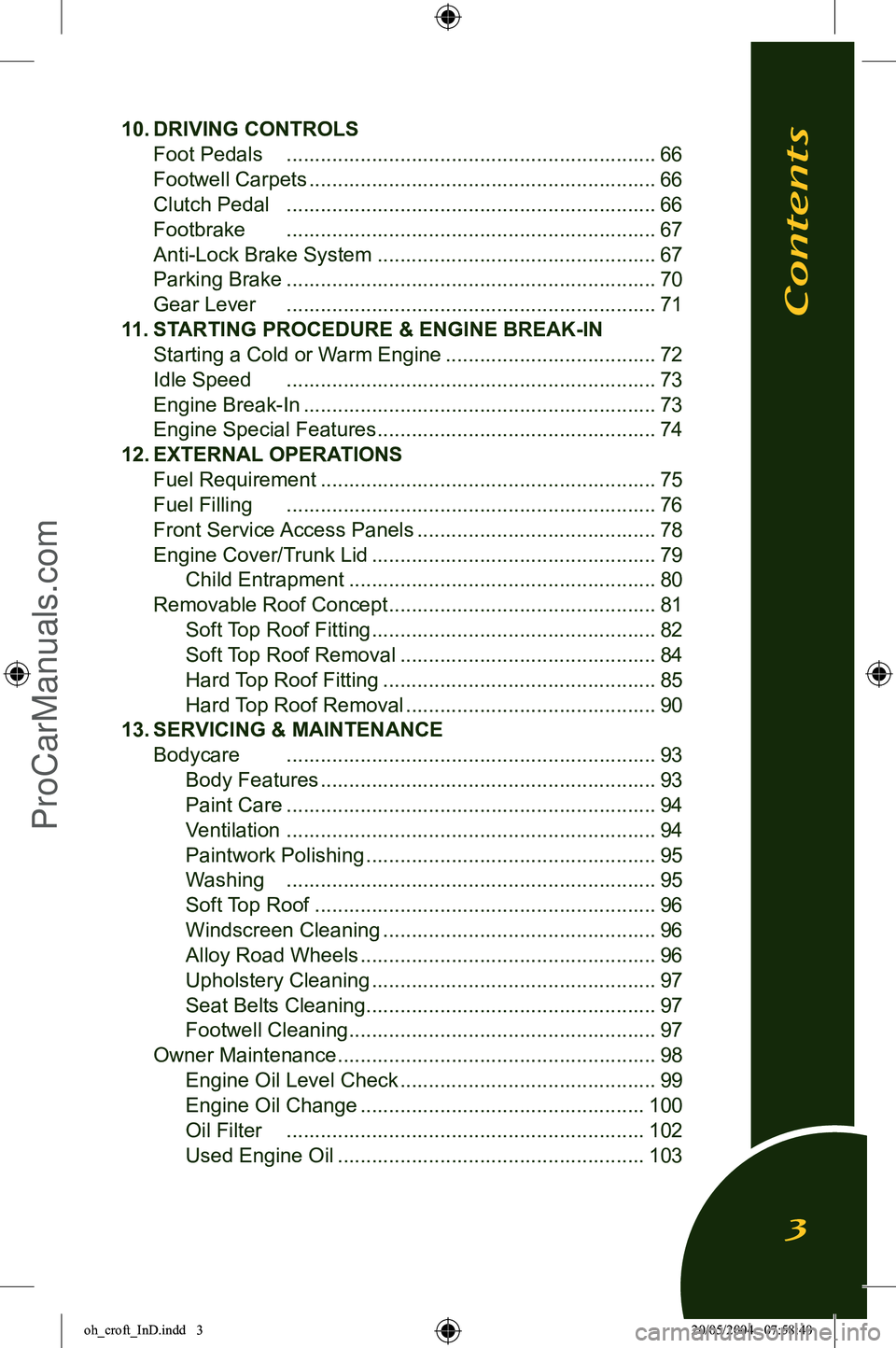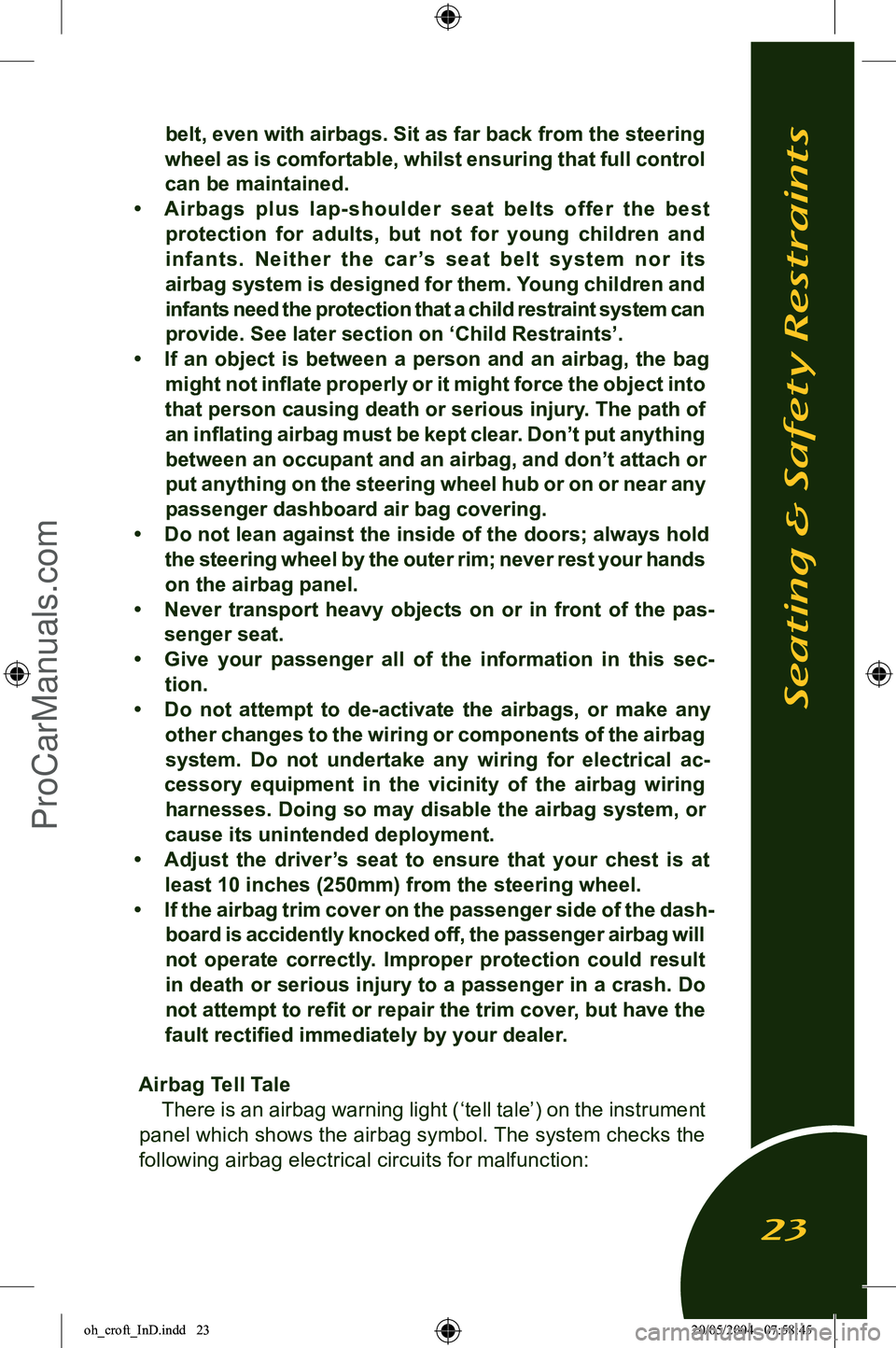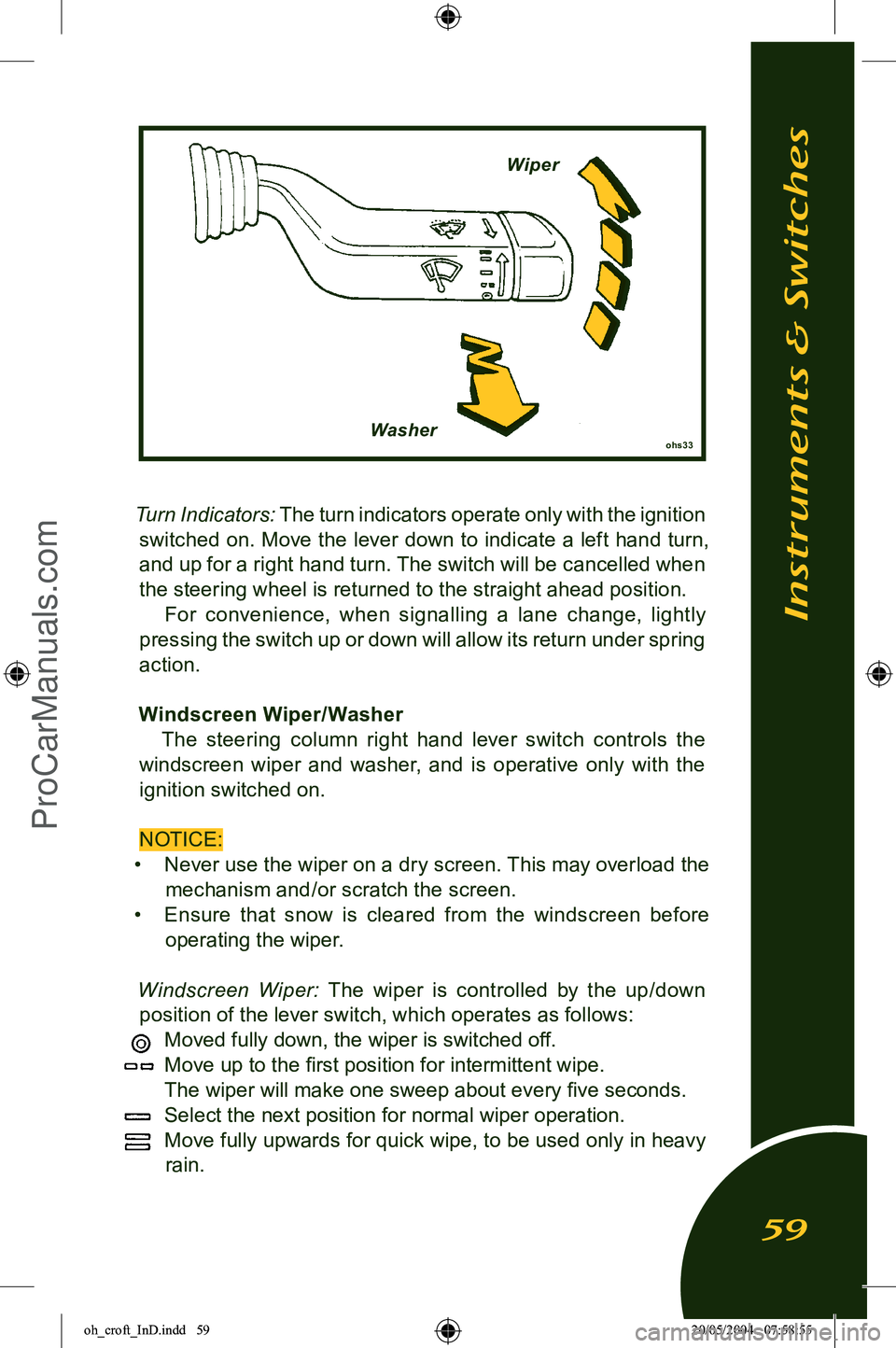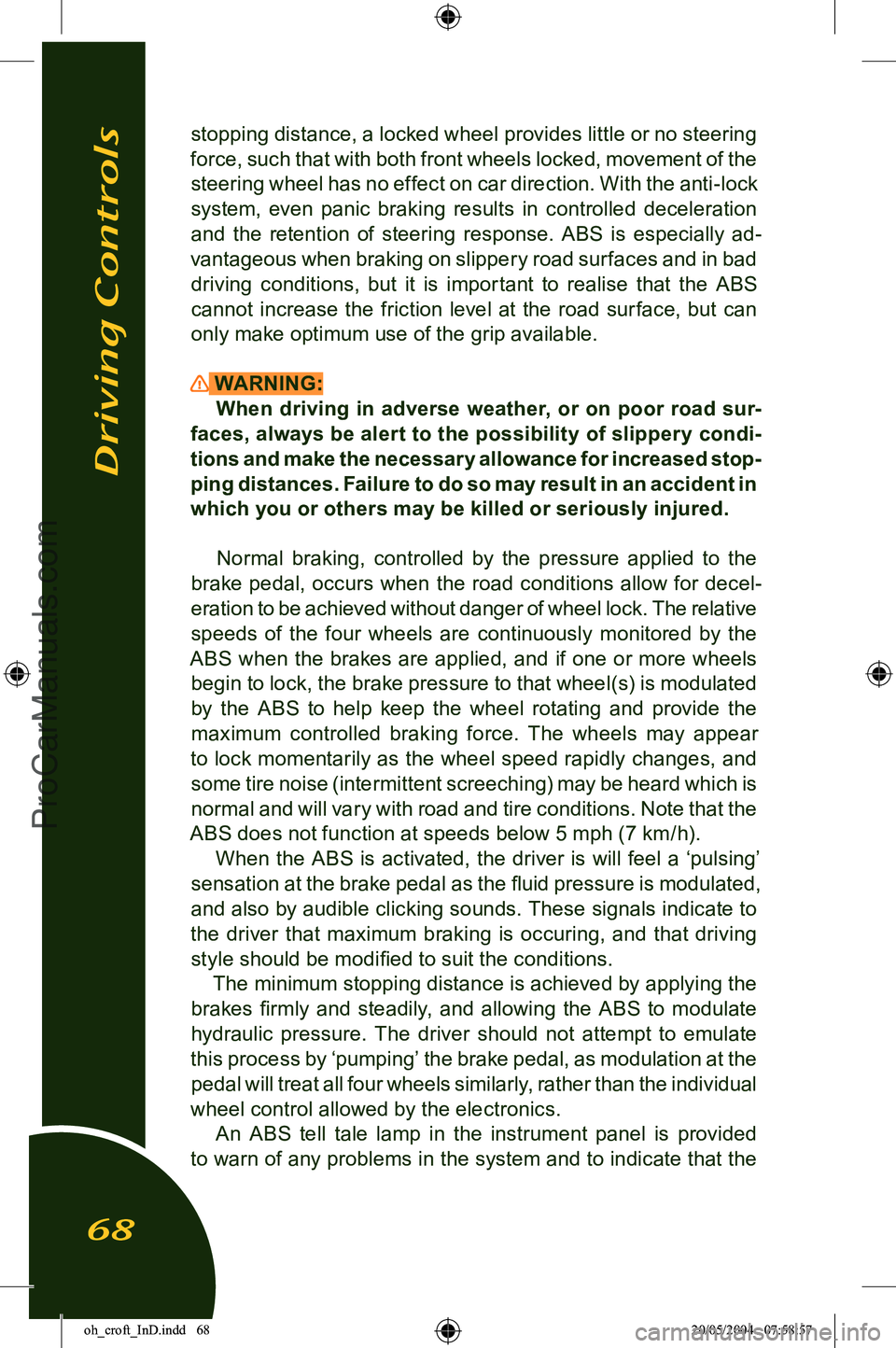change wheel LOTUS ELISE 2005 Owners Manual
[x] Cancel search | Manufacturer: LOTUS, Model Year: 2005, Model line: ELISE, Model: LOTUS ELISE 2005Pages: 205, PDF Size: 4.51 MB
Page 5 of 205

10. DRIVING CONTROLS
Foot Pedals .................................................................
66
Footwell Carpets .............................................................
66
Clutch Pedal .................................................................
66
Footbrake .................................................................
67
Anti-Lock Brake System .................................................
67
Parking Brake .................................................................
70
Gear Lever .................................................................
71
11. STARTING PROCEDURE & ENGINE BREAK-IN
Starting a Cold or Warm Engine .....................................
72
Idle Speed .................................................................
73
Engine Break-In ..............................................................
73
Engine Special Features .................................................
74
12. EXTERNAL OPERATIONS
Fuel Requirement ...........................................................
75
Fuel Filling .................................................................
76
Front Service Access Panels ..........................................
78
Engine Cover/Trunk Lid ..................................................
79
Child Entrapment ......................................................
80
Removable Roof Concept ...............................................
81
Soft Top Roof Fitting ..................................................
82
Soft Top Roof Removal .............................................
84
Hard Top Roof Fitting ................................................
85
Hard Top Roof Removal ............................................
90
13. SERVICING & MAINTENANCE
Bodycare .................................................................
93
B
ody Features ...........................................................93
Paint Care .................................................................
94
Ventilation .................................................................
94
Paintwork Polishing ...................................................
95
Washing .................................................................
95
Soft Top Roof ............................................................
96
Windscreen Cleaning ................................................
96
Alloy Road Wheels ....................................................
96
Upholstery Cleaning ..................................................
97
Seat Belts Cleaning ...................................................
97
Footwell Cleaning ......................................................
97
Owner Maintenance ........................................................
98
Engine Oil Level Check .............................................
99
Engine Oil Change ..................................................
100
Oil Filter ...............................................................
102
Used Engine Oil ......................................................
103
Contents
3
oh_croft_InD.indd 320/05/2004 07:58:40ProCarManuals.com
Page 25 of 205

belt, even with airbags. Sit as far back from the steering
wheel as is comfortable, whilst ensuring that full control can be maintained.
• Airbags plus lap-shoulder seat belts offer the best protection for adults, but not for young children and
infants. Neither the car ’s seat belt system nor its
airbag system is designed for them. Young children and
infants need the protection that a child restraint system can
provide. See later section on ‘Child Restraints’.
• If an object is between a person and an airbag, the bag
might not inflate properly or it might force the object into
that person causing death or serious injury. The path of an inflating airbag must be kept clear. Don’t put anything between an occupant and an airbag, and don’t attach or
put anything on the steering wheel hub or on or near any
passenger dashboard air bag covering.
• Do not lean against the inside of the doors; always hold the steering wheel by the outer rim; never rest your hands
on the airbag panel.
• Never transport heavy objects on or in front of the pas
-
senger seat.
• Give your passenger all of the information in this sec
-
tion.
• Do not attempt to de-activate the airbags, or make any other changes to the wiring or components of the airbag
system. Do not undertake any wiring for electrical ac
-
cessory equipment in the vicinity of the airbag wiring harnesses. Doing so may disable the airbag system, or
cause its unintended deployment.
• Adjust the driver’s seat to ensure that your chest is at
least 10 inches (250mm) from the steering wheel.
• If the airbag trim cover on the passenger side of the dash
-
board is accidently knocked off, the passenger airbag will
not operate correctly. Improper protection could result
in death or serious injury to a passenger in a crash. Do
not attempt to refit or repair the trim cover, but have the
fault rectified immediately by your dealer.
Airbag Tell Tale There is an airbag warning light (‘tell tale’) on the instrument
panel which shows the airbag symbol. The system checks the
following airbag electrical circuits for malfunction:
Seating & Safety Restraints
23
oh_croft_InD.indd 2320/05/2004 07:58:45ProCarManuals.com
Page 61 of 205

Turn Indicators: The turn indicators operate only with the ignition
switched on. Move the lever down to indicate a left hand turn, and up for a right hand turn. The switch will be cancelled when
the steering wheel is returned to the straight ahead position. For convenience, when signalling a lane change, lightly
pressing the switch up or down will allow its return under spring
action.
Windscreen Wiper/ Washer The steering column right hand lever switch controls the
windscreen wiper and washer, and is operative only with the ignition switched on.
NOTICE:
• Never use the wiper on a dry screen. This may overload the
mechanism and/or scratch the screen.
• Ensure th at snow is cleared from the windscreen before
operating the wiper.
Windscreen Wiper:
The wiper is controlled by the up/down
position of the lever switch, which operates as follows:
Moved fully down, the wiper is switched off.
Move up to the first position for intermittent wipe.
The wiper will make one sweep about every five seconds.
Select the next position for normal wiper operation.
Move fully upwards for quick wipe, to be used only in heavy
rain.
Instruments & Switches
59
ohs33Washer Wiper
oh_croft_InD.indd 5920/05/2004 07:58:55ProCarManuals.com
Page 70 of 205

stopping distance, a locked wheel provides little or no steering
force, such that with both front wheels locked, movement of the steering wheel has no effect on car direction. With the anti-lock
system, even panic braking results in controlled deceleration and the retention of steering response. ABS is especially ad
-
vantageous when braking on slippery road surfaces and in bad driving conditions, but it is important to realise that the ABS
cannot increase the friction level at the road surface, but can only make optimum use of the grip available.
WARNING: When driving in adverse weather, or on poor road sur
-
faces, always be alert to the possibility of slippery condi
-
tions and make the necessary allowance for increased stop
-
ping distances. Failure to do so may result in an accident in which you or others may be killed or seriously injured.
Normal braking, controlled by the pressure applied to the
brake pedal, occurs when the road conditions allow for decel
-
eration to be achieved without danger of wheel lock. The relative
speeds of the four wheels are continuously monitored by the
ABS when the brakes are applied, and if one or more wheels begin to lock, the brake pressure to that wheel(s) is modulated
by the ABS to help keep the wheel rotating and provide the
maximum controlled braking force. The wheels may appear
to lock momentarily as the wheel speed rapidly changes, and some tire noise (intermittent screeching) may be heard which is normal and will vary with road and tire conditions. Note that the
ABS does not function at speeds below 5 mph (7 km/h). When the ABS is activated, the driver is will feel a ‘pulsing’
sensation at the brake pedal as the fluid pressure is modulated, and also by audible clicking sounds. These signals indicate to
the driver that maximum braking is occuring, and that driving style should be modified to suit the conditions.
The minimum stopping distance is achieved by applying the
brakes firmly and steadily, and allowing the ABS to modulate
hydraulic pressure. The driver should not attempt to emulate
this process by ‘pumping’ the brake pedal, as modulation at the pedal will treat all four wheels similarly, rather than the individual
wheel control allowed by the electronics. An ABS tell tale lamp in the instrument panel is provided
to warn of any problems in the system and to indicate that the
Driving Controls
68
oh_croft_InD.indd 6820/05/2004 07:58:57ProCarManuals.com